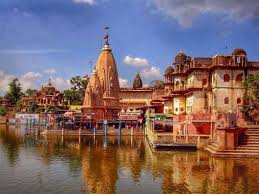Bakrasura’s Defeat and the Gopas’ Concern
After Krishna killed the demon Bakrasura, who had taken the form of a calf, the demigods showered flowers from the heavens in celebration, and all the cowherd boys (Gopas) joyfully embraced Krishna, exclaiming, “Well done, well done!” As Bakrasura assumed his original demoniac form, the Gopas ate Kapila fruits and continued their play.
However, the Gopas expressed their concern to Krishna, saying, “How can we continue to play with you? You have committed the sin of killing a calf. Although Bakrasura was a demon, he was still in the form of a calf, and the karma of killing a calf is severe. Even if a being is a demon internally, his external form was that of a sacred calf. We believe that to purify yourself, you must bathe in the holy waters of the Ganges.”
Krishna Creates Manasi Ganga
Understanding the concern of the Gopas, Krishna, who was near Govardhan Hill at the time, meditated deeply and invoked the Ganges (Ganga) within His mind. By His divine will, Gangadevi, the goddess of the Ganges, manifested herself in Vrindavan as Manasi Ganga, a sacred lake created from the mind of Krishna. Krishna then took a purifying bath in Manasi Ganga, and the Gopas followed, enjoying joyful pastimes together in the sacred waters. This event remained a secret among the Gopas.
Nanda and Yasoda’s Pilgrimage to the Ganges
One day, Nanda Maharaj and Yasoda were listening to a story (katha) about how Garuda, the mighty bird carrier of Lord Vishnu, had captured a lowly, envious snake. As Garuda was carrying the snake through the air, the tail of the snake briefly touched the waters of the Ganges. Instantly, the snake assumed a liberated, four-armed form, and Garuda, recognizing the transformation, placed the liberated being on his back and carried him personally to Vaikuntha, the spiritual realm.
When Nanda and Yasoda heard this incredible story, they shared it with the cowherd men and women. Inspired by the tale, they decided to go on a pilgrimage to bathe in the Ganges, believing that the holy waters would grant them liberation. They began making all the necessary arrangements, packing food and supplies for the journey.
Krishna Reveals Manasi Ganga
Krishna, seeing the preparations for the pilgrimage, asked, “What are you doing? Where are you going?” The cowherd community replied, “We are going to bathe in the Ganges for liberation.” Krishna smiled and assured them, “There is no need to travel far. All the holy places are here in Vraj (Vrindavan). The Ganges is already here. I will show you.”
Krishna then led them to Manasi Ganga, and by His divine wish, the presiding deity of the Ganges, Gangadevi, emerged from the waters, seated on her crocodile carrier, blessing everyone with her presence. The Vrajavasis (residents of Vrindavan) were astonished and realized that Krishna had brought the sacred Ganges to Vrindavan through His divine will. Overwhelmed with devotion, they offered ghee lamps, flowers, and prayers, and they all took a sacred bath in Manasi Ganga.
This particular event took place during the festival of Diwali, and it remains a cherished memory among the devotees of Vrindavan.
Lessons to Be Learned from the Story of Manasi Ganga
- The Power of Devotion and Purity:
- The Gopas’ concern for Krishna’s purity, even though Bakrasura was a demon, demonstrates the importance of maintaining spiritual purity and devotion. Their suggestion to bathe in the Ganges reflects their deep reverence for the holy river as a means of spiritual purification.
- Krishna’s Compassion and Divine Will:
- Krishna’s creation of Manasi Ganga reveals His compassion and willingness to address the concerns of His devotees. By manifesting the Ganges in Vrindavan, Krishna shows that all holy places reside within the heart of a pure devotee and that He is always ready to fulfill the desires of those who love Him.
- The Presence of the Divine in Everyday Life:
- The story illustrates how Krishna brings the sacred into the lives of His devotees. The Vrajavasis, who initially planned a pilgrimage, realized that the divine is present wherever Krishna is. This teaches us to recognize the sacred in our daily lives and to understand that true pilgrimage is a journey of the heart.
- The Importance of Faith and Surrender:
- The Vrajavasis’ faith in Krishna and their surrender to His guidance allowed them to experience the divine in their own land. This highlights the significance of placing complete trust in the Lord’s will and following His instructions with devotion.
Prayer for Devotion and Spiritual Purity
O Supreme Lord Krishna, source of all purity and compassion, We bow before You, seeking Your blessings and grace.
May we always remain devoted to You, Purifying our hearts and minds with the waters of Your love.
Like the Gopas, may we recognize the sacredness of every moment, And see Your divine presence in all aspects of our lives.
O Lord, guide us to walk the path of faith and surrender, Trusting in Your will, as we seek refuge in Your holy name.
May we always remember that with You, All holy places and divine blessings are ever present in our hearts.
Hare Krishna, Hare Krishna, Krishna Krishna, Hare Hare, Hare Rama, Hare Rama, Rama Rama, Hare Hare.



